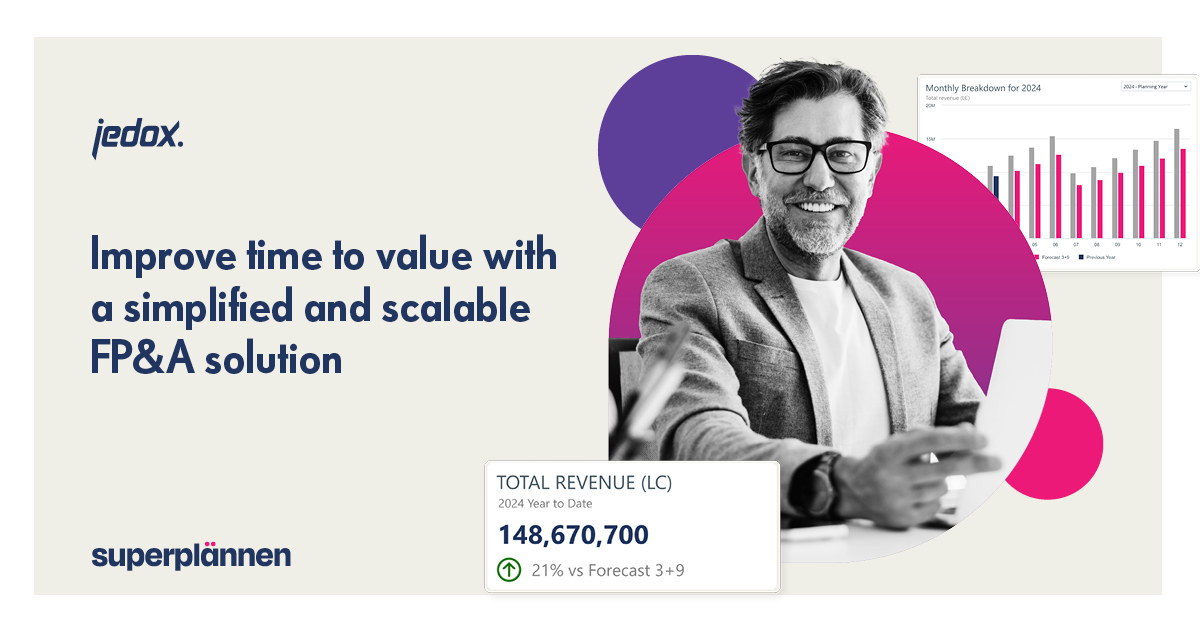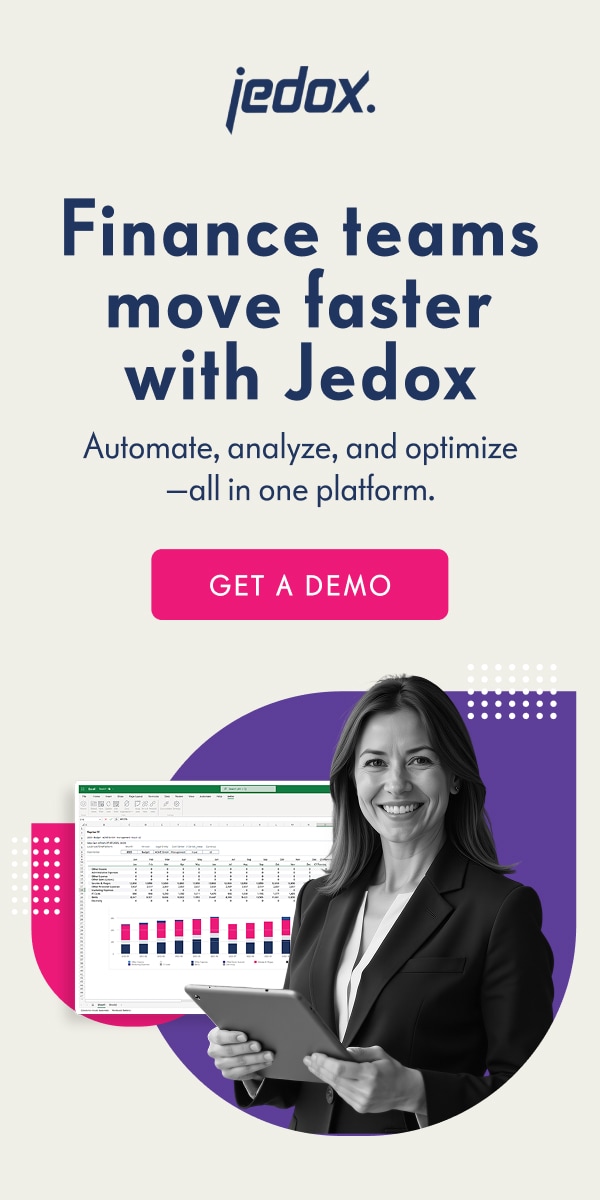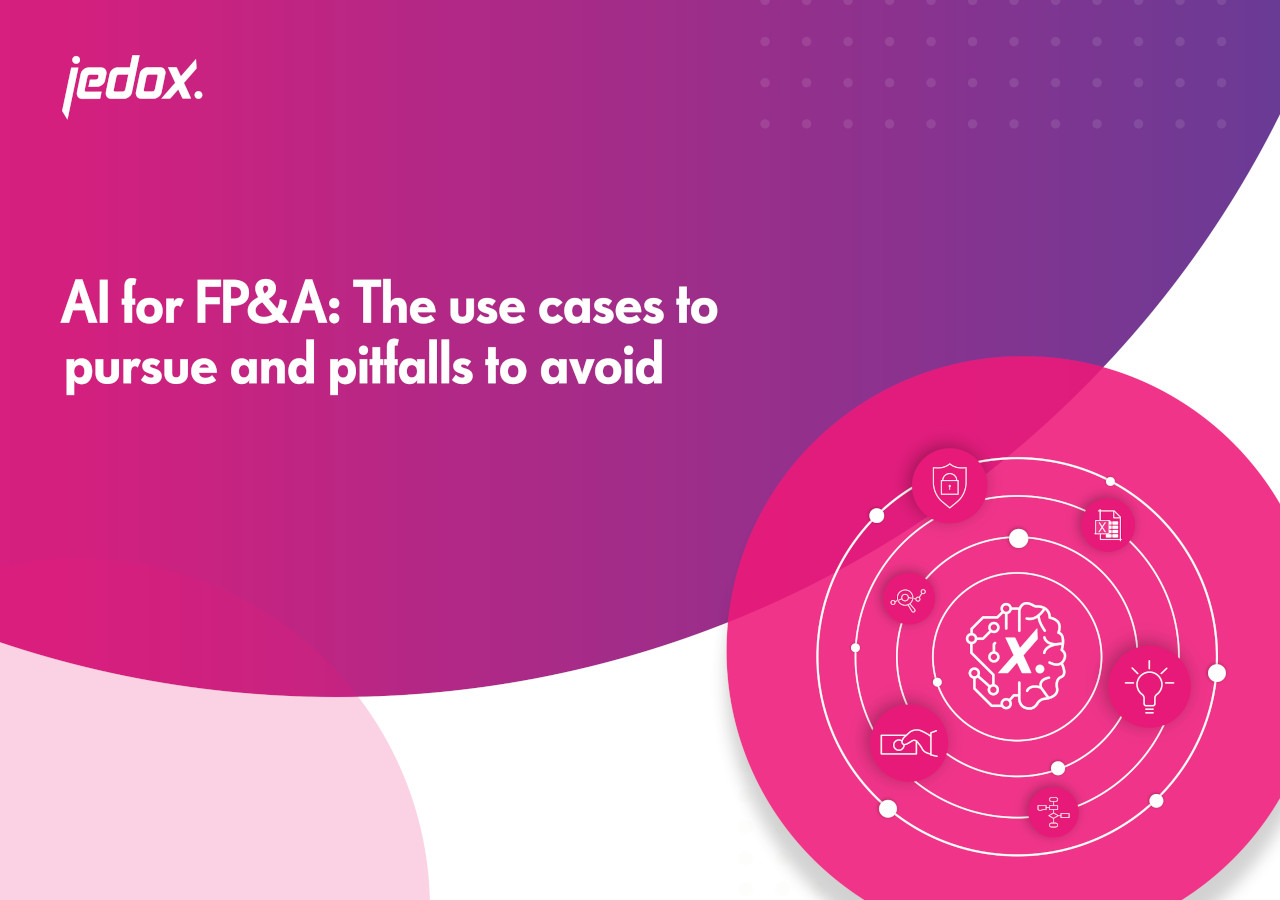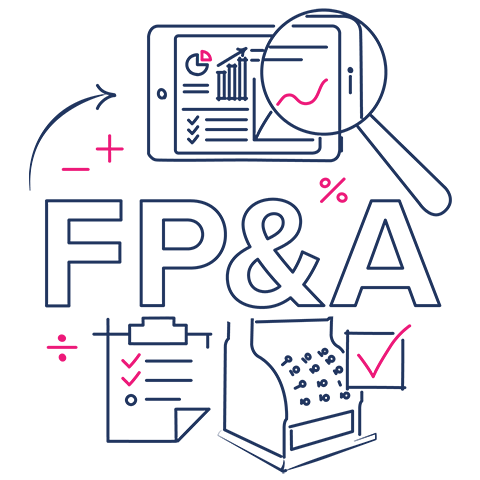
What is FP&A? The strategic powerhouse of modern Finance
- What is FP&A?
- Why FP&A is critical for businesses
- Key FP&A functions and use cases
- How to implement a best-in-class FP&A process
- FP&A’s role in financial strategy and decision-making
- How FP&A improves financial accuracy and agility
- FP&A vs. accounting: What is the difference?
- Key challenges FP&A solves
- The future of FP&A
- How Jedox streamlines FP&A
- Real-world impact: FP&A success stories with Jedox
- Strategic FP&A: The key to long-term business success
Financial planning and analysis (FP&A) is a vital component of corporate Finance, responsible for budgeting, forecasting, planning, and supporting strategic decision-making. It provides insights that drive efficiency, growth, and profitability, ensuring businesses remain financially agile and competitive.
FP&A professionals analyze financial data, market trends, and operational performance to help leadership make informed decisions. In this blog post, we explore the fundamental role of FP&A in business success, how it differs from traditional accounting, and its impact on financial strategy, accuracy, and agility. We also discuss key challenges businesses face in financial planning and how FP&A software can help organizations streamline their processes for better decision-making and profitability.
What is FP&A?
FP&A sits at the intersection of Finance and corporate management, bridging financial activities with business operations. Its primary objectives include liquidity management, financial planning, and optimizing resources for long-term profitability.
FP&A also plays a role in financial consolidation—enabling accurate group reports, timely financial statements, and robust financial control. By aligning financial strategies with business objectives, FP&A helps organizations sustain growth and enhance financial performance.
Why FP&A is critical for businesses
FP&A plays a key role in ensuring a company’s financial stability and long-term growth. By providing accurate financial forecasts and scenario planning, FP&A enables businesses to make informed decisions, allocate resources efficiently, and mitigate financial risks.
It also helps organizations adapt to changing market conditions, ensuring agility and resilience in dynamic industries. For chief financial officers (CFOs), FP&A is essential for financial planning, strategy, and fiscal discipline. It provides insights that help manage cash flow, align corporate objectives, and ensure financial sustainability.
Key FP&A functions and use cases
FP&A plays a pivotal role in business planning and financial management.
Its core components include:
- Planning, budgeting, and forecasting: These are the core components of enterprise performance management (EPM). FP&A helps organizations develop realistic financial plans, allocate resources effectively, and adjust strategies based on evolving business conditions
- Reporting and analysis: Reporting provides key financial insights and raises essential questions, while analysis interprets data to drive strategic business decisions
- Predictive forecasting: By leveraging AI and advanced analytics, predictive forecasting enhances traditional business forecasting. It helps organizations identify patterns, establish causal relationships, and anticipate future financial trends
- Financial consolidation: FP&A facilitates the combination of multiple financial statements into consolidated reports that comply with various legal and regulatory requirements
- Ad-hoc management reporting: Businesses need fast, accurate, and flexible reporting to address urgent financial inquiries. Ad-hoc reporting enables real-time decision-making by providing customized financial insights
- Zero-based budgeting: This budgeting approach starts from zero for each budgeting period, requiring justification for all expenses rather than just new costs. Zero-based budgeting ensures financial discipline and cost efficiency
- Top-down and bottom-up planning: FP&A supports both top-down and bottom-up planning approaches, ensuring alignment between corporate goals and departmental execution
How to implement a best-in-class FP&A process
Building a robust FP&A function requires a strategic approach that integrates technology, data, and collaboration.
Here are 5 key steps to developing an effective FP&A process:
- Establish clear financial goals: Define long-term business objectives and key performance indicators (KPIs) that will guide financial planning and decision-making
- Leverage the right FP&A tools: Implement advanced FP&A software to automate financial processes, enhance data analysis, and improve forecasting accuracy
- Improve data integration and reporting: Ensure seamless data flow between departments by consolidating financial data from multiple sources into a unified system
- Foster cross-department collaboration: Encourage collaboration between Finance, Operations, and other departments to align business strategies with financial planning
- Continuously optimize & adapt: Regularly assess FP&A processes, refine financial models, and leverage predictive analytics to improve accuracy and agility
By following these steps, businesses can create a dynamic FP&A function that supports strategic growth and enhances financial performance.
FP&A’s role in financial strategy and decision-making
FP&A serves as the analytical foundation for major financial decisions, such as capital investments and cost-cutting measures. The FP&A process begins with financial planning, analyzing historical data to establish a baseline, and forecasting future revenues and expenditures. Once the actual situation is assessed, FP&A professionals compare it with the company’s financial targets to create a financial forecast.
Overall, this process ensures financial resources are allocated effectively to meet business goals. By integrating financial planning with performance analysis, businesses can make informed, agile decisions that drive sustainable growth.
How FP&A improves financial accuracy and agility
Financial accuracy, agility, and cost control are critical for businesses operating in fast-paced environments.
FP&A enhances these aspects by:
- Implementing data-driven forecasting methods to improve financial predictability
- Automating financial processes to minimize errors and inefficiencies
- Providing real-time insights that enable swift decision-making
- Enhancing cross-functional collaboration to ensure aligned financial planning
- Identifying cost-saving opportunities and optimizing resource allocation
- Continuously monitoring financial performance to pinpoint inefficiencies and track expenditures
By leveraging these capabilities, FP&A professionals ensure businesses remain adaptable and profitable.
FP&A vs. accounting: What is the difference?
While both functions deal with financial data, their primary functions differ. Accounting focuses on historical data —recording, classifying, and reporting financial transactions for compliance, auditing, and financial reporting purposes. FP&A is forward-looking —analyzing financial trends, forecasting future outcomes, and guiding strategic decision-making to align with corporate objectives.
They are also differentiated by:
- Scope: Accounting ensures financial accuracy and compliance with regulatory standards, while FP&A provides actionable insights that drive business performance and future growth
- Decision-making support: FP&A enables proactive decision-making by evaluating business scenarios, whereas accounting primarily documents past financial activity
- Technology and tools: FP&A leverages data analytics, automation, and advanced modeling techniques, while accounting relies on financial reporting systems and compliance-driven processes
Together, FP&A and accounting form a comprehensive financial management system that ensures both compliance and long-term financial success.
Key challenges FP&A solves
Modern businesses face several financial challenges that FP&A can help address.
With the right FP&A software, organizations can:
- Make better, more data-driven decisions: FP&A provides accurate and timely insights, allowing business leaders to base strategic decisions on comprehensive data rather than intuition and align their financial plans with overall business goals
- Provide leadership with a holistic view of business: FP&A integrates data across departments—breaking down data silos, ensuring a unified financial view, and eliminating inconsistencies
- Improve operational efficiency and reduce manual work: Many organizations rely heavily on manual processes and spreadsheets, which can be time-consuming and prone to errors. Automating FP&A processes reduces this reliance on Excel, enhancing accuracy and freeing up valuable resources to focus on higher-value strategic activities
- Enhance cross-departmental collaboration and alignment: Lack of collaboration between departments can lead to misaligned strategies and inefficiencies. FP&A fosters cross-functional communication, ensuring that financial planning is coordinated across all business units—which helps align financial goals with overall company objectives
- Enable agile scenario planning and accurate forecasting: Rapidly changing market conditions require businesses to plan for multiple outcomes. Advanced FP&A tools use predictive analytics and scenario modeling to improve forecasting accuracy—allowing leaders to evaluate various financial scenarios and make agile, informed decisions
By leveraging FP&A, businesses can drive efficiency, improve forecasting accuracy, and achieve long-term financial success.
The future of FP&A
As technology evolves, FP&A is transforming with new tools and methodologies that enhance its capabilities.
The future of FP&A is being shaped by several key trends:
- AI & machine learning: AI-powered analytics enable deeper insights, improving forecasting accuracy and automating routine financial processes
- Predictive analytics: Leveraging data trends and statistical modeling, predictive analytics help organizations anticipate financial outcomes and adjust strategies proactively
- Cloud-based FP&A tools: Cloud platforms offer greater flexibility, real-time collaboration, and enhanced data integration, enabling more efficient financial planning
- Integration with ERP & business intelligence systems: Seamless integration with enterprise resource planning (ERP) and business intelligence (BI) systems ensures comprehensive financial visibility and strategic alignment
How Jedox streamlines FP&A
Jedox provides a powerful FP&A solution that streamlines financial planning, analysis, forecasting, and reporting.
The key benefits of using Jedox include:
- Enhanced data integration: Centralizes financial data for accurate analysis and reporting
- Streamlined process automation: Reduces manual work and minimizes errors in financial planning
- Advanced predictive analytics: Improves financial forecasts and scenario modeling for better decision-making
- User-friendly interface: Enables cross-functional collaboration and accessibility for Finance teams with a familiar, Excel-like interface
Real-world impact: FP&A success stories with Jedox
Successful FP&A implementation has driven transformative outcomes for businesses across industries. By leveraging Jedox’s innovative software, companies have streamlined their financial processes, improved forecasting accuracy, and enhanced strategic decision-making:
C&A
The global fashion retailer streamlined its financial planning operations, reducing planning time by 66%. This allowed the Finance team to focus on strategic decision-making rather than manual data management. With enhanced scenario planning capabilities, C&A can now anticipate market changes more effectively and allocate resources more efficiently.
Mitsui Chemicals
The multinational chemical company significantly improved its forecasting process, achieving a 95% accuracy rate in sales predictions. This improvement enabled the company to optimize inventory management, reduce costs, and ensure supply chain efficiency. With Jedox, Mitsui Chemicals gained a deeper understanding of market trends, allowing them to proactively adjust their business strategies.
Papa John’s (PJP Investments Group LLC)
The international pizza chain revolutionized its financial planning with 3x faster forecasting and 10X faster scenario analysis. These capabilities allowed leadership to respond quickly to changing market conditions, optimize pricing strategies, and improve overall operational efficiency. By integrating Jedox, PJP enhanced its ability to make data-driven, profitable decisions.
Strategic FP&A: The key to long-term business success
FP&A is a cornerstone of modern Finance, driving strategic financial planning and operational agility. As businesses navigate complexity, FP&A’s role continues to evolve with AI, predictive analytics, and cloud-based automation.
By leveraging modern FP&A solutions like Jedox, organizations can enhance financial accuracy, improve forecasting, and drive sustainable growth.
What does FP&A stand for? (FP&A meaning)
FP&A stands for financial planning & analysis. It’s a critical business function that helps organizations plan, forecast, and analyze financial performance to support strategic decision-making.
How is FP&A different from traditional accounting?
While accounting focuses on recording past financial transactions, ensuring compliance, and preparing financial statements, FP&A is forward-looking. It helps organizations forecast future financial outcomes, allocate resources efficiently, and make data-driven strategic decisions based on trends and market conditions.
What are the key components of FP&A?
FP&A consists of four core components that help businesses manage financial planning effectively. Planning and budgeting involve establishing financial plans and setting spending limits. Forecasting predicts financial performance based on historical data and market trends. Financial reporting analyzes and presents key financial metrics to stakeholders, while scenario planning models different financial outcomes to assess potential risks and opportunities.
Why is FP&A important for modern businesses?
A strong FP&A function enables companies to make informed, data-driven decisions that improve financial accuracy, reduce risk, and align financial goals with business strategy. By providing real-time insights, FP&A helps businesses navigate market uncertainties and drive sustainable growth.
How does Jedox improve FP&A processes?
Jedox enhances FP&A by automating processes to reduce manual data entry and improve efficiency. Its AI-driven forecasting leverages machine learning for more accurate financial predictions, while seamless data integration connects with Excel, ERP, and BI tools to consolidate financial data. Collaborative workflows enable Finance teams to work more effectively on planning and reporting. With Jedox, businesses can eliminate time-consuming manual processes, enhance financial visibility, and make faster, more accurate decisions.
What are the best FP&A software solutions?
The right FP&A software depends on factors such as company size, industry, existing tech stack, and specific financial planning needs. Some top options include: Jedox, Anaplan, Adaptive Insights (Workday Adaptive Planning), Oracle Hyperion Planning and Wolters Kluwer.

